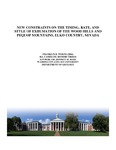| dc.rights.license | In Copyright | en_US |
| dc.creator | Wolfe, Franklin D. | |
| dc.date.accessioned | 2016-07-27T14:47:05Z | |
| dc.date.available | 2016-07-27T14:47:05Z | |
| dc.date.created | 2016 | |
| dc.identifier | WLURG38_Wolfe_GEOL_2016 | |
| dc.identifier.uri | http://hdl.handle.net/11021/33563 | |
| dc.description | Thesis; [FULL-TEXT FREELY AVAILABLE ONLINE] | en_US |
| dc.description | Franklin D. Wolfe is a member of the Class of 2016 of Washington and Lee University. | en_US |
| dc.description.abstract | In this study, zircon (U-Th)/He analysis is used to documents the timing, rate, and style of exhumation of the Wood Hills and Pequop Mountains, which are part of the Ruby Mountains-East Humboldt Range metamorphic core complex. This is a premier natural laboratory in the Basin and Range Province for studying the dynamics of metamorphic core complexes, because it exposes middle to lower crustal rocks (~30 km deep) and the kinematics of exhumation are well-constrained in a mylonitic shear zone on the western extent of the complex. What makes this complex unique is that the footwall was dissected by later high-angle normal faults, which have preserved the higher structural levels of the complex at their current position (Wood Hills and Pequop Mountains) and exposed the deeper levels beneath the mylonitic zone (East Humbolt Range). Great debate has emerged over the timing of on-set of exhumation of the core complex along the Ruby Mountain Detachment Fault. Some argue that it began during Miocene or younger times, which is consistent for the dominant phase of extension throughout the Basin and Range, whereas, others believe it began during earlier times (Oligocene to Eocene). Results from this study reveal that slip along the Ruby Mountain Detachment Fault must have begun by Oligocene, but probably Eocene times. The trend in younging of apparent 40Ar/39Ar muscovite, biotite, and hornblende ages towards the NW, which has been documented for the Southern Ruby Mountains by Colgan et al. (2010) and the East Humboldt Range by McGrew and Snee (1994), is consistent with the findings presented here for the Wood Hills and Pequop Mountains. Lastly, the Pequop Mountains reached temperatures (depths) high enough to reset zircon (U-Th)/He thermochronometers; however, inconclusive evidence is found to confidently declare that the exhumation of these mountains is due to slip along the Ruby Mountain Detachment Fault. | en_US |
| dc.format.extent | 71 pages | en_US |
| dc.language.iso | en_US | en_US |
| dc.rights | This material is made available for use in research, teaching, and private study, pursuant to U.S. Copyright law. The user assumes full responsibility for any use of the materials, including but not limited to, infringement of copyright and publication rights of reproduced materials. Any materials used should be fully credited with the source. | en_US |
| dc.rights.uri | http://rightsstatements.org/vocab/InC/1.0/ | en_US |
| dc.subject.other | Washington and Lee University -- Honors in Geology | en_US |
| dc.title | New Constraints on the Timing, Rate, and Style of Exhumation of the Wood Hills and Pequop Mountains, Elko County, Nevada (thesis) | en_US |
| dc.type | Text | en_US |
| dcterms.isPartOf | RG38 - Student Papers | |
| dc.rights.holder | Wolfe, Franklin D. | |
| dc.subject.fast | Metamorphic rocks -- Analysis | en_US |
| dc.subject.fast | Faults (Geology) | en_US |
| dc.subject.fast | Nevada -- Elko County | en_US |
| local.department | Geology | en_US |
| local.scholarshiptype | Honors Thesis | en_US |
